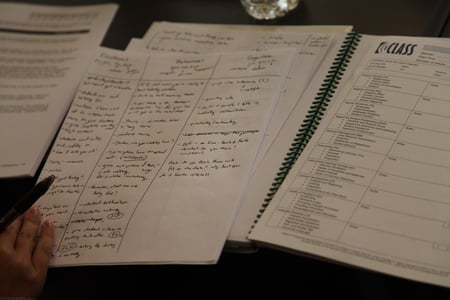
CLASS observer drift is a simple concept. It is a term we use to describe what happens when an observer becomes less reliable. The more an observer drifts, the less likely the CLASS data he or she collects will be valid.
Contrary to some beliefs, conducting reliable CLASS observations is not like riding a bike. It is a skill that must be practiced, just like playing a sport or musical instrument. Let’s say you tried out for the tennis team and made it (congratulations)! Then you found out your first match is in six weeks. Would you wait around until the match to pick up a racket? Of course you wouldn’t—you’d be out on the courts perfecting your serve and practicing your backhand every day! You can apply this analogy to CLASS observer certification. You may have completed the training and passed the test (congratulations!), but you still need to practice to keep your skills on point for the big match (in this case, a high stakes CLASS observation).
Catching Drift
There are many strategies for overcoming drift such as setting up regular CLASS calibrations, creating opportunities for double coding, and monitoring data for red flags. But how does drift happen in the first place?
Three Reasons Reliable Observers Drift
- You never double code outside your bubble: In this instance, you’re trying to do your best by dual coding alongside other observers to stay calibrated. This is usually a great strategy and allows you to practice justifying your codes to another person. This practice can become problematic, however, if you consistently dual code with the same people. Why? Groups often tend to drift together. Think about it: If drift is all about losing objectivity or forgetting the process, people that code together also develop misconceptions together—and are actually at risk of reinforcing reliability issues, rather than resolving them. If you’re in the practice of dual coding, pat yourself on the back—then make sure you are coding with a variety of observers (better if you can collaborate with people outside of your own organization if possible).
- Your treat your coding skills like an annual physical: Once a year, you get the dreaded email from Teachstone reminding you to recertify. But why is it so scary? It shouldn’t be if you have been practicing your observation skills on a regular basis! If you have not, then you may find you really need to cram for the test. You might pass, but what does this say about the data you are collecting if you do not plan to pick up your manual again for another six months? We observers owe it to children to take our practice seriously.
- You dive right into the deep end before testing out the kiddie pool: Coding a few classroom videos to become certified is one thing; conducting a live observation in a real classroom is another. Make a plan to conduct some low-stakes observations after becoming certified to really learn the tricks of the trade and what works for you. (You’d be surprised how many first-time observers forget to bring a water bottle to their 2-hour long observation!)
Back in April, I had the pleasure of delivering a presentation on this very topic at the InterAct CLASS Summit in Austin, TX. The presentation focused on high-stakes CLASS data collection and strategies for keeping standards of reliability high. I can’t take all the credit—my co-presenter, Susan McGraw, was responsible for the concept and lives the challenges of CLASS observer drift every day as she coordinates and conducts assessments in California and beyond. You can check out a recording of our presentation here!

